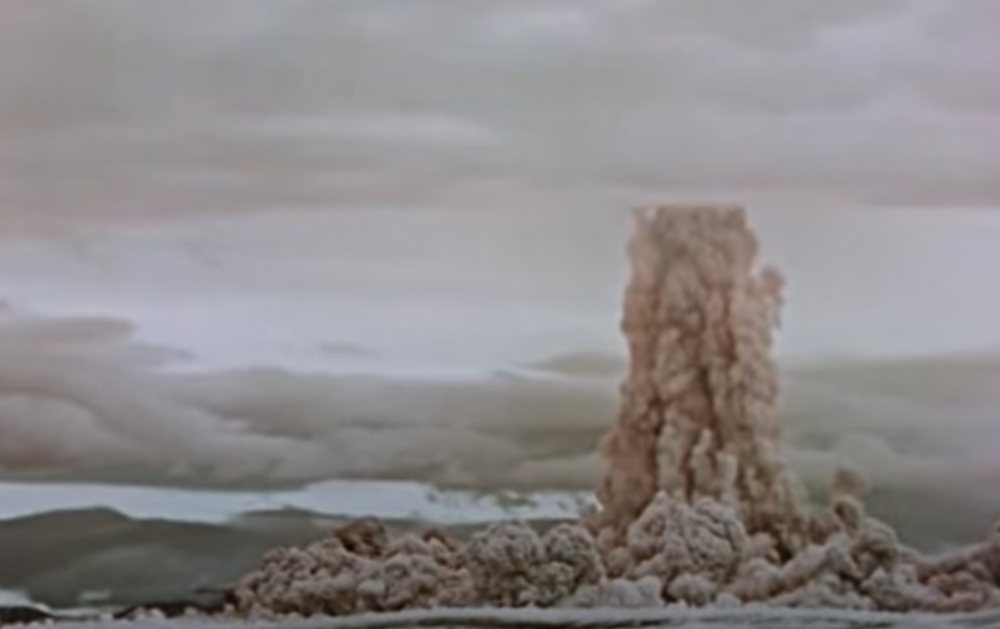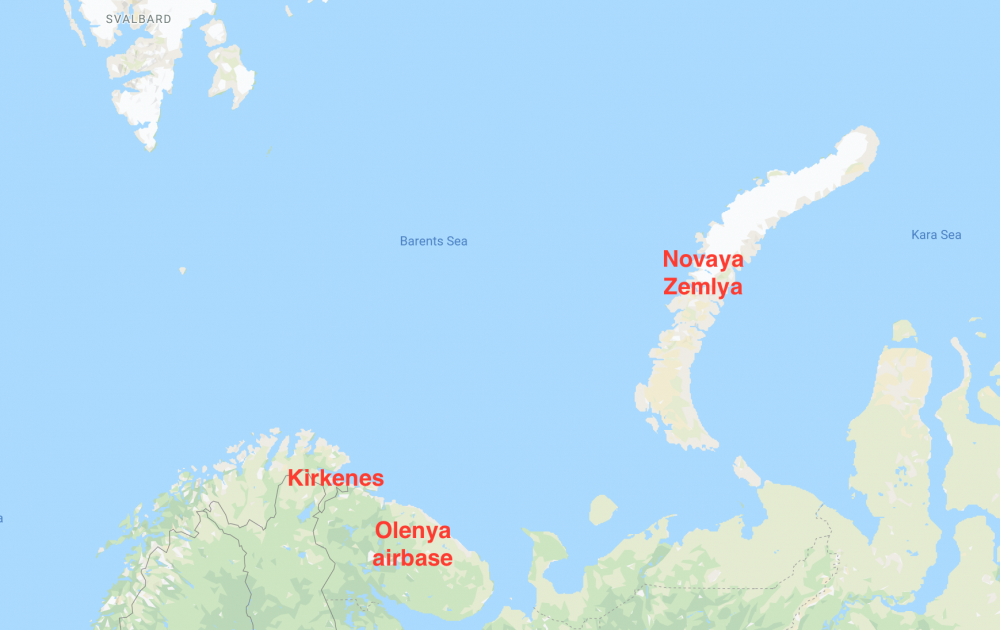Counter-Errorist
THINK TANK
Photos and short video clips have previously been available, but this unseen 40 minutes declassified footage of the Soviet Union’s monster nuclear bomb give a whole new insight into what happened on Novaya Zemlya on October 30, 1961.
Thomas Nilsen | August 22, 2020
The documentary film was released and posted on August 20 on the YouTube channel of Rosatom State Atomic Energy Corporation in connection with the celebration of 75 years of nuclear industry.
The film, edited in classic Soviet-style propaganda, shows all preparation procedures. First the transportation of the giant bomb by rail to the Olenya airbase near Olenegorsk on the Kola Peninsula. The Tu-95 aircraft take-off and flight across the Barents Sea to the detonation site near the Matochkin Strait at Novaya Zemlya.
Then the release of the bomb attached to a parachute to slow the fall so the plane could get in safer distance from the blast. Videos from several directions and distances show the apocalypse looking detonation and following mushroom cloud.
The bomb, officially named RDS-220 and later nick-named Tsar Bomba, was the largest nuclear weapon ever constructed.
With a yield of 50 megatons (50 million tons), equal to around 3,800 Hiroshima bombs, the weapon was set off over Novaya Zemlya on October 30, 1961.
It was Soviet Premier Nikita Khrushchev who in July 1961 ordered the development of the doomsday-size bomb at a time amid rising political tensions between the Soviet Union and the United States.
Khrushchev wanted a 100 megaton weapon and to achieve such size, the engineers added a third stage on the thermonuclear warhead. Normal hydrogen bombs comprise two stages. Understanding the extreme radiation releases, the engineers, and among them Andrei Sakharov, decided to reduce the actual yield of 100 megatons to around half.
The film shows how the modified Tu-95 bomber plane was coated with a special white reflective paint to protect it from the heat caused by thermal radiation from the explosion. Measurement equipment was attached all over and a second plane flew beside, filming and monitoring radiation samples.
To slow the drift down after release, the bomb was deployed to a giant parachute, itself weighing nearly a ton.
The bomb was detonated 4,000 meters above the ground. As seen in the film, the fireball flash lasted far longer than seen on any other nuclear weapon test videos. The flash dome itself reached 20 km, while the ring of absolute destruction had a radius of 35 kilometers.
After 40 seconds, the dome of the fire reached 30 km and thereafter developed into a mushroom cloud which soared to a height of 60-65 kilometers with a diameter of 90 km. In the military town Severny, center for the nuclear weapons test around the Matochkin Strait, most buildings were destroyed. The town was 55 kilometers from ground zero.

A few seconds after the explosion, the diameter of the dust column was about 10 km. Screenshot from the film
Although being detonated four kilometers above the ground, the seismic shock wave equivalent to an earthquake of over 5.0 on the Richter scale was measured around the world.
The Tu-95 plane carrying the bomb was far away at the time of detonation. However, the explosion’s shock wave caused the aircraft to instantly lose 1,000 meters of altitude, but it later landed safely.
In Norway, military border guards on the Jarfjord Mountain near Kirkenes could see the flash. In the film, it is said the light from the flash could be seen at a distance of 1,000 kilometers.
 Map: The Barents Observer
Map: The Barents Observer
Radiation fallout was measured all over Scandinavia, and international condemnation followed.
Domestic protests were also voiced inside the USSR, among them from Andrei Sakharov who began speaking out against nuclear weapons. In his book, Memoirs, Sakharov wrote in detail against the Soviet leadership’s policies. In 1975, Sakharov was awarded the Nobel Peace Prize, but Moscow denied him permission to go to Oslo for the ceremony.
After the Tsar Bomba and other thermonuclear tests on Novaya Zemlya and by the United States in the Pacific, the two superpowers realized the craziness of conducting atmospheric tests with huge radioactive fallouts. In 1963, the United States and the Soviet Union signed the Partial Nuclear Test Ban Treaty banning tests in the atmosphere, outer space and underwater.
Consequently, nuclear weapons tests were conducted underground. The last two such tests took place at Novaya Zemlya on October 24, 1990.
In 1996, the UN adopted the Comprehensive Nuclear Test Ban Treaty, prohibiting any nuclear weapon test explosion or any other nuclear explosions.
Thomas Nilsen | August 22, 2020
The documentary film was released and posted on August 20 on the YouTube channel of Rosatom State Atomic Energy Corporation in connection with the celebration of 75 years of nuclear industry.
The film, edited in classic Soviet-style propaganda, shows all preparation procedures. First the transportation of the giant bomb by rail to the Olenya airbase near Olenegorsk on the Kola Peninsula. The Tu-95 aircraft take-off and flight across the Barents Sea to the detonation site near the Matochkin Strait at Novaya Zemlya.
Then the release of the bomb attached to a parachute to slow the fall so the plane could get in safer distance from the blast. Videos from several directions and distances show the apocalypse looking detonation and following mushroom cloud.
The bomb, officially named RDS-220 and later nick-named Tsar Bomba, was the largest nuclear weapon ever constructed.
With a yield of 50 megatons (50 million tons), equal to around 3,800 Hiroshima bombs, the weapon was set off over Novaya Zemlya on October 30, 1961.
It was Soviet Premier Nikita Khrushchev who in July 1961 ordered the development of the doomsday-size bomb at a time amid rising political tensions between the Soviet Union and the United States.
Khrushchev wanted a 100 megaton weapon and to achieve such size, the engineers added a third stage on the thermonuclear warhead. Normal hydrogen bombs comprise two stages. Understanding the extreme radiation releases, the engineers, and among them Andrei Sakharov, decided to reduce the actual yield of 100 megatons to around half.
The film shows how the modified Tu-95 bomber plane was coated with a special white reflective paint to protect it from the heat caused by thermal radiation from the explosion. Measurement equipment was attached all over and a second plane flew beside, filming and monitoring radiation samples.
To slow the drift down after release, the bomb was deployed to a giant parachute, itself weighing nearly a ton.
The bomb was detonated 4,000 meters above the ground. As seen in the film, the fireball flash lasted far longer than seen on any other nuclear weapon test videos. The flash dome itself reached 20 km, while the ring of absolute destruction had a radius of 35 kilometers.
After 40 seconds, the dome of the fire reached 30 km and thereafter developed into a mushroom cloud which soared to a height of 60-65 kilometers with a diameter of 90 km. In the military town Severny, center for the nuclear weapons test around the Matochkin Strait, most buildings were destroyed. The town was 55 kilometers from ground zero.

A few seconds after the explosion, the diameter of the dust column was about 10 km. Screenshot from the film
Although being detonated four kilometers above the ground, the seismic shock wave equivalent to an earthquake of over 5.0 on the Richter scale was measured around the world.
The Tu-95 plane carrying the bomb was far away at the time of detonation. However, the explosion’s shock wave caused the aircraft to instantly lose 1,000 meters of altitude, but it later landed safely.
In Norway, military border guards on the Jarfjord Mountain near Kirkenes could see the flash. In the film, it is said the light from the flash could be seen at a distance of 1,000 kilometers.

Radiation fallout was measured all over Scandinavia, and international condemnation followed.
Domestic protests were also voiced inside the USSR, among them from Andrei Sakharov who began speaking out against nuclear weapons. In his book, Memoirs, Sakharov wrote in detail against the Soviet leadership’s policies. In 1975, Sakharov was awarded the Nobel Peace Prize, but Moscow denied him permission to go to Oslo for the ceremony.
After the Tsar Bomba and other thermonuclear tests on Novaya Zemlya and by the United States in the Pacific, the two superpowers realized the craziness of conducting atmospheric tests with huge radioactive fallouts. In 1963, the United States and the Soviet Union signed the Partial Nuclear Test Ban Treaty banning tests in the atmosphere, outer space and underwater.
Consequently, nuclear weapons tests were conducted underground. The last two such tests took place at Novaya Zemlya on October 24, 1990.
In 1996, the UN adopted the Comprehensive Nuclear Test Ban Treaty, prohibiting any nuclear weapon test explosion or any other nuclear explosions.
